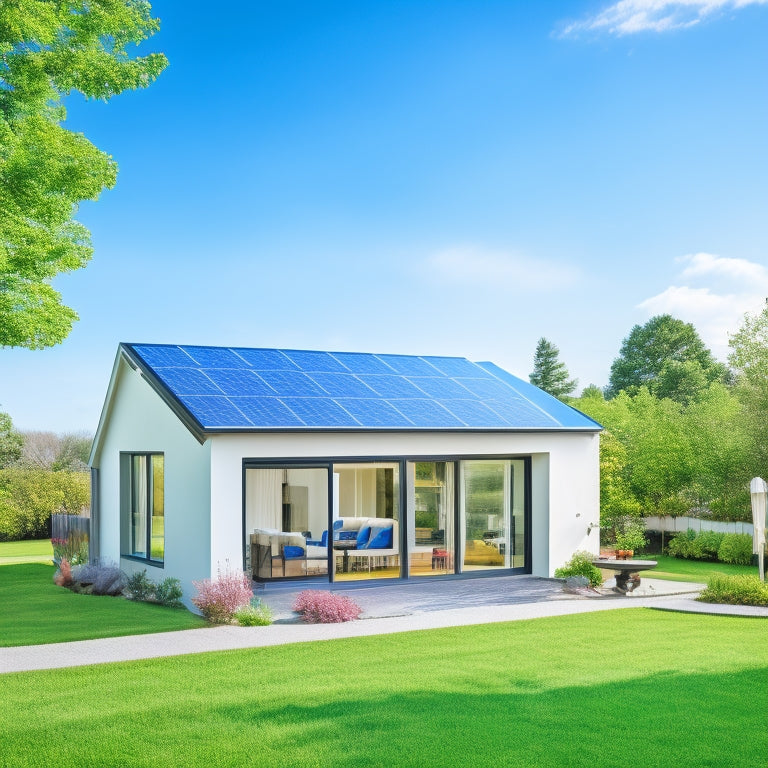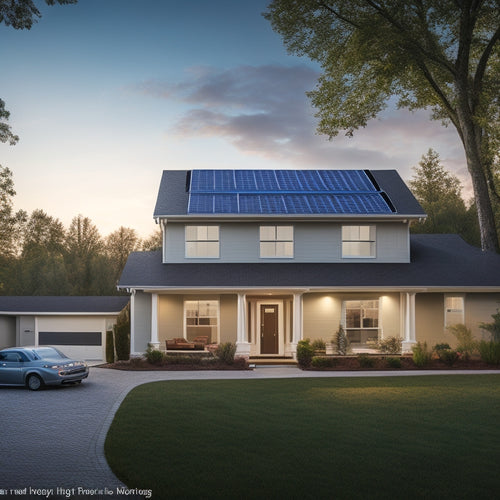
5 Best Energy Independence System Installation Costs
Share
You're looking to invest in an energy independence system, and the cost is likely a top consideration, with prices ranging from $12,500 for a typical residential solar panel system to $30,000 or more for advanced systems with battery backup and monitoring. Installation prices vary by location due to regional labor costs and permits, and system size and complexity greatly affect overall costs. Financing options, government incentives, and local building codes also impact the final bill. As you weigh your options, understanding the costs of different components, from solar panels to monitoring systems, is essential - and exploring the details can reveal useful perspectives into creating an efficient and cost-effective energy independence system.
Overview
- Average cost of solar panels ranges from $2.50 to $3.50 per watt, with a typical 5-kilowatt residential system costing $12,500 to $17,500.
- Installation prices vary by location due to regional labor costs and permits, with off-grid systems potentially being cost-effective in areas with high electricity rates.
- Monitoring systems, which track production and consumption in real-time, can add $1,000 to $3,000 to the overall installation cost, depending on complexity.
- Battery backup system installation fees range from $5,000 to $15,000 for basic systems, and up to $30,000 for advanced systems with higher capacities.
- Balancing system size with budget and energy needs is crucial, with larger systems generally incurring higher costs but potentially leading to greater energy savings.
Average Solar Panel Costs
When considering an energy independence system, understanding the costs of solar panels is vital. You'll want to know that the average cost of solar panels ranges from $2.50 to $3.50 per watt. A typical residential solar panel system is around 5 kilowatts, putting the total cost between $12,500 and $17,500.
However, high-efficiency solar panels can increase the cost to up to $20,000 or more. System size and complexity affect costs exponentially, so it's important to balance these factors to meet specific energy needs effectively.
The type and quality of equipment also play a significant role in overall system cost and performance. Fortunately, financing options are available to help make solar energy more accessible.
You can investigate government incentives, solar loans, or power purchase agreements to find a financing solution that works for you. By understanding the costs and financing options, you can make an informed decision about investing in solar panels for your energy independence system.
Installation Prices by Location
You'll find that installation prices for energy independence systems vary greatly depending on your location. Regional differences in labor costs, permits, and installation incentives contribute to these disparities.
Off-grid solar power systems, which reduce reliance on non-renewable energy sources, can be more cost-effective in areas with high electricity rates or limited traditional infrastructure. For instance, states like California and Massachusetts offer attractive installation incentives, such as rebates and tax credits, which can considerably reduce your upfront costs.
On the other hand, areas with lower labor costs, like the Midwest, may have lower installation prices overall. Additionally, local building codes and permitting requirements can also impact installation costs.
Be sure to research the specific incentives and regulations in your area to get an accurate estimate of your energy independence system installation costs.
System Size and Cost Factors
As you research installation costs for your energy independence system, another key factor to contemplate is the system size and its impact on overall expenses. The larger the system, the more expensive it becomes.
However, a larger system can also lead to greater energy savings and increased system efficiency, similar to high-efficiency solar charging solutions that maximize energy harvest. Additionally, advanced features such as built-in monitoring and control provide real-time energy observations, which can help enhance system performance.
You'll need to balance these factors to determine the ideal system size for your needs and budget.
Additionally, financing options can affect the upfront cost of the system. Be sure to investigate available financing options, such as loans or power purchase agreements, to find the best fit for your situation.
Monitoring System Add-On Costs
With your energy independence system in place, incorporating a monitoring system can greatly enhance its performance and efficiency. This add-on allows you to track your system's production and consumption in real-time, identifying areas for improvement.
Proper energy needs assessment is essential to optimize the system's performance, and regular monitoring can help pinpoint areas for operational enhancement. You'll need to evaluate the cost of monitoring software, which can range from $500 to $2,000, depending on the complexity of the system.
Installation features, such as data loggers and sensors, will also impact the overall cost. On average, you can expect to pay an additional $1,000 to $3,000 for an all-encompassing monitoring system.
Battery Backup Installation Fees
When optimizing your energy independence system, a monitoring system can only take you so far.
To guarantee continuous power supply during outages, you'll need a battery backup system. The installation fees for this component vary depending on the battery technology and capacity you choose.
On average, you can expect to pay between $5,000 and $15,000 for a basic battery backup system. However, more advanced systems with higher capacities can cost upwards of $30,000.
Be certain to also factor in installation warranties, which can range from 5 to 10 years, depending on the provider.
When selecting a battery backup system, consider your energy needs and budget to guarantee you're getting the best value for your investment.
Frequently Asked Questions
What Are the Benefits of Using a Microinverter Versus a String Inverter?
You'll find that microinverters offer several advantages over string inverters, including improved efficiency, reduced shading losses, and increased design flexibility, while string inverters have drawbacks like single-point failure and limited panel mismatch tolerance.
Can I Install an Energy Independence System on a Rented Property?
You're considering installing an energy independence system on a rented property, but you'll face unique installation challenges, such as obtaining landlord approval and ensuring system removal is feasible when your lease ends.
How Long Does a Typical Energy Independence System Installation Take?
As you commence your energy independence expedition, you're probably wondering how long it'll take to break free from the grid. The installation timeline varies, but typically takes 2-6 weeks, depending on factors like system size, complexity, and local permits.
Are There Any Local Building Codes or Permits Required for Installation?
You'll need to traverse local regulations, ensuring compliance with building codes and securing necessary permits before installation; research permit processes, consulting with local authorities to guarantee a smooth, hassle-free experience.
Can I Expand My Energy Independence System in the Future?
"Don't put all your eggs in one basket" - you're wise to think about future scalability. Yes, you can expand your energy independence system later; design it with modular components to facilitate seamless system upgrades, ensuring a flexible and sustainable path to freedom from grid reliance.
Ready to Buy
You've got the keys to releasing energy independence in your hands. As you set out on this modern-day quest for self-sufficiency, remember that every watt counts. With the right system, you'll be utilizing the power of the sun like a 21st-century alchemist, turning sunlight into savings. So, go ahead and flip the switch – your wallet (and the planet) will thank you.
Related Posts
-

How to Achieve a Zero-Waste Lifestyle for a Greener Tomorrow
To achieve a zero-waste lifestyle, start by adopting the principles of refusing, reducing, reusing, and recycling. Sw...
-

Top Camping Water Bottles for Adventure
When you're out adventuring, picking the right camping water bottle is essential for staying hydrated. Look for durab...
-

Cost of Solar With Battery Backup
You're investing in a solar panel system with battery backup to guarantee reliable power during outages. The cost of ...


